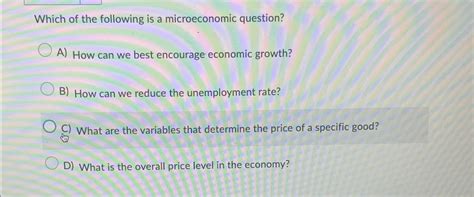Microeconomics is the branch of economics that studies the behavior of individual entities, such as households, firms, and individuals. Microeconomic questions focus on how these entities make decisions and how their decisions affect the market.

Here are some examples of microeconomic questions:
- What is the price of a gallon of milk?
- How many people are employed in the manufacturing sector?
- What is the marginal cost of producing an additional unit of a good?
- How do consumers decide how much of a good to buy?
- How do firms decide how much of a good to produce?
Here are some examples of macroeconomic questions:
- What is the inflation rate?
- What is the unemployment rate?
- What is the GDP?
- What is the fiscal policy of the government?
- What is the monetary policy of the central bank?
As you can see, microeconomic questions focus on the behavior of individual entities, while macroeconomic questions focus on the behavior of the economy as a whole.
Why does it Matter?
Microeconomics is important because it helps us to understand how markets work. This understanding can be used to improve public policy and make better economic decisions. For example, microeconomic analysis can be used to:
- Design policies to promote economic growth
- Regulate industries to protect consumers and promote competition
- Set prices for goods and services
- Allocate resources efficiently
Benefits
Microeconomics can provide a number of benefits, including:
- Improved decision-making: Microeconomic analysis can help businesses make better decisions about pricing, production, and marketing.
- Increased efficiency: Microeconomic analysis can help businesses identify and eliminate inefficiencies in their operations.
- Greater profitability: Microeconomic analysis can help businesses increase their profits by identifying opportunities to improve their products and services.
- Improved public policy: Microeconomic analysis can help governments design policies that promote economic growth and improve the well-being of citizens.
FAQs
Q: What is the difference between microeconomics and macroeconomics?
A: Microeconomics studies the behavior of individual entities, while macroeconomics studies the behavior of the economy as a whole.
Q: What are some examples of microeconomic questions?
A: Some examples of microeconomic questions include: What is the price of a gallon of milk? How many people are employed in the manufacturing sector? What is the marginal cost of producing an additional unit of a good? How do consumers decide how much of a good to buy? How do firms decide how much of a good to produce?
Q: What are some examples of macroeconomic questions?
A: Some examples of macroeconomic questions include: What is the inflation rate? What is the unemployment rate? What is the GDP? What is the fiscal policy of the government? What is the monetary policy of the central bank?
Q: Why is microeconomics important?
A: Microeconomics is important because it helps us to understand how markets work. This understanding can be used to improve public policy and make better economic decisions.
Q: What are some benefits of microeconomics?
A: Some benefits of microeconomics include: Improved decision-making, increased efficiency, greater profitability, and improved public policy.
Conclusion
Microeconomics is a powerful tool that can be used to understand how markets work. This understanding can be used to improve public policy, make better economic decisions, and improve the well-being of citizens.
